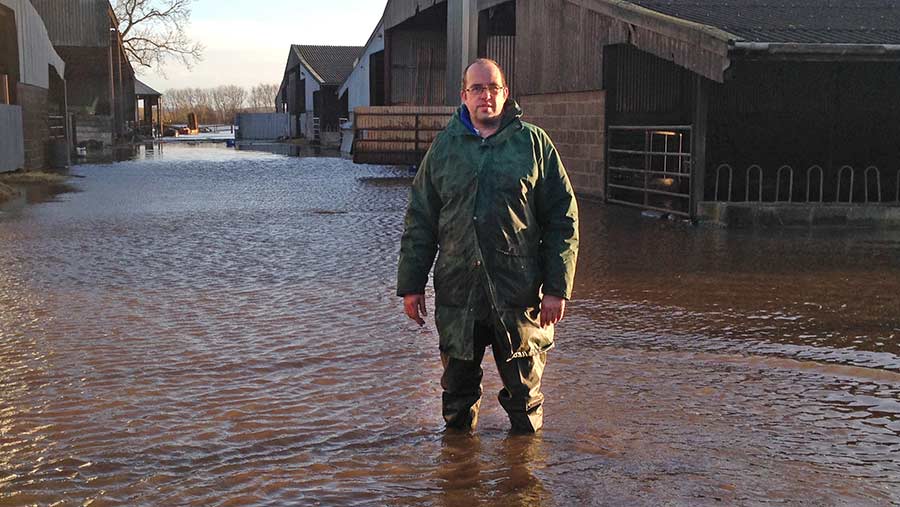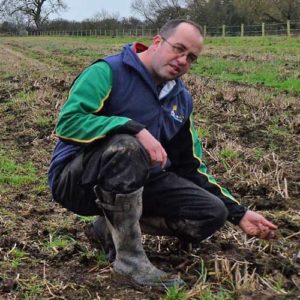How farmers changed their management in wake of Somerset floods
It has been three years since the Somerset Levels were hit by flooding and, in that time, much has changed.
Farms have had to change the way they manage their land, both on the levels themselves and in surrounding higher ground.
But there are important lessons that can be learned, especially as policymakers try to develop new ways of supporting farmers post-Brexit in a way that has wider public appeal.
This time three years ago, the water was rising fast around James Winslade’s farmhouse in the Somerset Levels.

James Winslade and his family had to evacuate their Somerset farm after flooding reached dangerous heights
Within a week, it would be half way up his first floor window and, after a hasty exit, James, his wife, aging parents and his 600 cattle would be temporarily lodged in different locations around the county.
It would stay that way for the next three-and-a-half months, until they could finally return at the start of spring to a farm and home devastated by water damage.
See also: Somerset farmer’s flood struggle
At the time, while news of the “worst floods in 250 years” dominated headlines, it was stories about the outpouring of support from farmers and communities nationwide that most captured the nation’s attention.
Following a tweet sent out by Mr Winslade’s wife asking for help getting emergency forage for their cattle, farmers around Britain sent hundreds of tonnes of silage down to Somerset, in what the NFU said was the largest movement of forage in British history.
Helping hands quickly followed, coming from as far away as Scotland to shift and feed livestock from flooded farms.
But while collaboration is the success story of the floods of winter 2013-14, it was the lack of joined-up thinking among different quarters that has been widely blamed for causing the problem in the first place.
While the rainfall experienced in Somerset was exceptional, responsibility for the subsequent flooding was spread wide.
Under-dredged watercourses, poor urban planning decisions and land management in the upper river catchments were all blamed.
Without a collaborative approach, the combined effect of water moving inexorably from hills to levels, had been all but ignored as local councils, business and farmers all chased their own goals.
The result was devastating, both economically and emotionally.
Suicides spiked in the months after the floods as people came to terms with the damages.
The total bill for the floods was put at £147m, while farmers such as the Winslades were left many thousands of pounds in debt.
New approach

James Winslade
In the aftermath of the floods, there was a realisation that, in order to prevent such an event happening again, things needed to be managed differently.
While dredged rivers, upgraded drainage and pumping stations could better remove excess water in times of need, the solution would have to look to the cause as well as the effect.
Ben Thorne is a senior farm conservation adviser with the Farming and Wildlife Advisory Group South West (FWAG SW).
Along with other partners like the Royal Bath & West Society, local Wildlife Trust and RSPB, he helped set up the Hills to Levels project in summer 2014.
The project looks to manage flooding through natural processes, working with farmers across the entire 350,000ha of the Somerset Levels catchment.
It is funded by Players of the People’s Postcode Lottery and forms one part of a wider flood action plan, run by the Somerset Rivers Authority (SRA).
To date, Mr Thorne and his team of advisers have worked with more than 750 farmers, from the Mendip Hills down through the levels and up towards Exmoor, to create land use change that will help prevent flooding in the future.
“The nature of water is to move on and, for all but the lowest lying farms, to quickly become someone else’s problem”, he says.
“But this belies the nature of how water and land management work together – every farm, every field and every stream has a part to play in managing flooding.
“To prevent flooding in the long term, we need to think on a catchment scale and to look at the natural processes that can slow water down as it runs off the hills.
“We are encouraging farmers in the hills and farmers on the levels to work together to make this happen.”
Water storage
Central to the Hills to Levels approach is the role soil can play in storing water. Drawing on available funding from the SRA as well as Countryside Stewardship schemes, FWAG SW encourages farmers to use a range of methods to improve soil health and structure, from subsoiling through to sowing deep rooting leys.
This can both “slow the flow of water while also bringing multiple other benefits to farmers and society, from improved fertility through to enhanced biodiversity”, says Mr Thorne.
Alongside the focus on soil, FWAG SW is also working with farmers to create natural barriers in places where water flow is fastest.
Farmers are being funded to build bunds, construct woody dams in streams and put in leaky ponds.
“We have detailed maps that allow us to understand how and where water moves in different weather events,” says Mr Thorne.
“And we know the natural processes that store it, slow it and direct it.
“The goal is to restore those processes to allow natural features to minimise flood risk not only for farmers and local villages, but for the big towns that lie in the flood plains as well.”
A tale of recovery
Three years after the flood, James Winslade’s 344ha farm in Moorland is now in better shape than ever before.
Immediately after the flood, his arable land and pastures were bereft of life and heavily compacted from holding the weight of 10ft of water for 15 weeks.
He realised that he needed to make a change, both to quickly restore fertility and to hedge against such an event happening again.
His first move was to buy two bits of kit – a sward lifter and an aerator.
The machinery brought air back into the soil and allowed for water and manure to penetrate down to the roots.
At the same time, he started experimenting with cover crops in his arable fields to encourage soil stability and build up fertility.
Mr Winslade’s farm covers areas of clay, loam and peat soil, but the result was similar across every field: “The worm population exploded and within two years I had two to three inches of high-quality compost on the surface as a result of biological activity in the soil”, he says.
“That then allowed me to move towards a zero-tillage operation, direct drilling straight into the soil so as to not disturb the structure and biological life.
“The result is my yields have gone significantly up, fertiliser use has fallen and my fields are far more resilient to flooding”.
Government is realising farmers are vital for flood solution
Case study: Mark Pope, Staple Farm, Staple Fitzpaine, Somerset
Standing at the top of Mark Pope’s 304ha arable farm in the Blackdown Hills on a clear day, you can look down to James Winslade’s fields, 10 miles in the distance.
Intercut by streams that run off the slopes, Mr Pope’s fields are a key source of the water that periodically floods the land down below.

Mark Pope
As part of the Hills to Levels project, Mr Pope and Farming and Wildlife Advisory Group South West have used flow-pathway maps to analyse the movement of water across his fields and determine a course of action.
In one field with a history of flash flooding, he built a large soil bund fitted with an overflow, to store run-off and gradually release it into a stream.
In others, he laid a series of coir rolls, which slow the overland flow of water and prevent soil movement.
The condition of the soil also plays a crucial role in slowing run-off.
Over the past three years, Mr Pope has experimented with a number of new techniques to improve his soil structure, including subsoiling, strip-tillage and changing his rotation to match the capability of the land.
Across 49ha, he sowed deep rooting grasses, which he also sells as feedstock to a nearby anaerobic digestion plant.
“Flooding is one of the NFU’s key issues and we are looking at natural flood-management measures nationwide,” says Mr Pope, who also chairs the NFU environment forum.
“We certainly think the government is beginning to realise farmers have a very important role to play in managing flooding.
“If the right support package can be put together, we could have farmers across the country building flood-management into their businesses, with hill farmers slowing water up, and lowland farmers building water storage capacity, to help protect nearby towns.”
Insight: Future policy options
In this time of political uncertainty, it is hard to say what future agricultural policy will look like and, crucially, how land-management incentives will be funded, writes Luke Dale-Harris
However, looking at the Future Flood Prevention report released late last year by the Environment, Food and Rural Affairs Committee, it seems likely natural flood-management will play a growing role.
The report calls for a joined-up, catchment-based approach to replace Britain’s current flood-management schemes, which it describes as “fragmented, inefficient and ineffective”.
If done right, the report claims flood-management measures can give multiple benefits, such as “to protect water quality for drinking, to lower agricultural pollution, to improve habitat, or to restore landscapes that store carbon”.
How much this will influence future policy will be made clear later this year, when the government releases its 25-year ambition for flood-risk reduction in the context of climate change.
But, for now, as budgets tighten and a changing climate threatens to make flooding, such as that witnessed in the winter of 2013-14, other parts of the country could have something to learn from the Somerset experience.
